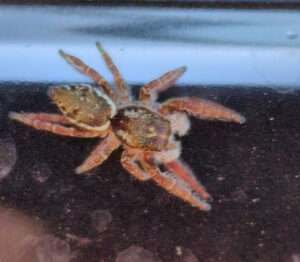 If you’ve ever seen a photo of a spider and responded “KILL IT WITH FIRE!!!!!”, or responded to a picture of a snake (even someone’s pet snake) with “a well-aimed shotgun will fix that”–do you even hear yourself? Do you just kneejerk respond to the very existence of an animal with a desire to end its life?
If you’ve ever seen a photo of a spider and responded “KILL IT WITH FIRE!!!!!”, or responded to a picture of a snake (even someone’s pet snake) with “a well-aimed shotgun will fix that”–do you even hear yourself? Do you just kneejerk respond to the very existence of an animal with a desire to end its life?
Let’s skip the whataboutism: I’m not talking about food here, or humane euthanasia (to include of invasive species). I’m also not talking about legitimate phobias of certain animals. Nor is this about animals that are actively causing harm that cannot be otherwise mitigated, cases of self-defense, or habituated mammals that are becoming increasingly aggressive and don’t respond to hazing. I’m talking specifically about the seemingly unexamined violent and hateful response so many people have to certain animals, not because they are an active threat, but simply because they are there. I’ve seen it applied to not just snakes and spiders, but also coyotes, bears, wolves, foxes, moles, voles, hawks, and all sorts of other native species that have been a part of various American ecosystems for millennia.
The justification always seems to be “Well, it could hurt someone/kill livestock/damage my lawn” and so forth. Except–is it? Is that animal currently causing a problem? Or do you just feel entitled to preemptively end its existence, instead of taking steps to exclude it or otherwise protect people and property? And how important is what you’re supposedly protecting anyway? I can’t fathom the idea that a perfectly smooth, boring grass lawn is more important than the vital ecological roles moles play in keeping subterranean insects in check and enhancing the soil microbiome through their digging. (After all, pocket gophers aren’t the only fossorial species that make a difference to soil health!)
Never mind that we have lots of non-lethal options for co-existing with various animals. There are tons of fencing designs that will exclude whatever potential predator you worry about getting in with your livestock. Most bugs can be captured with a drinking glass and a postcard and released safely outside. You can get inexpensive but effective snake tongs and hooks for relocating snakes. Sure, it takes a little more effort than just squashing the bug or beating the snake to death with a shovel, but is your laziness worth the life of another being?
 I know, I know. The sorts of people who say this sort of thing are usually the sorts who crow back with “well, we’re top of the food chain!” Never mind, of course, that our understanding of ecology has moved on from the hierarchical image of the food chain, and replaced it with more accurate imagery of a food web in which nutrients are constantly cycling among many living beings, all of which are equally important to the process. Western society has at this point spent millennia convincing ourselves that humans are not animals, that we’re better than other animals, that nature is here for us to use and abuse as we see fit. Convenient how we’ve written all these myths justifying our actions, isn’t it?
I know, I know. The sorts of people who say this sort of thing are usually the sorts who crow back with “well, we’re top of the food chain!” Never mind, of course, that our understanding of ecology has moved on from the hierarchical image of the food chain, and replaced it with more accurate imagery of a food web in which nutrients are constantly cycling among many living beings, all of which are equally important to the process. Western society has at this point spent millennia convincing ourselves that humans are not animals, that we’re better than other animals, that nature is here for us to use and abuse as we see fit. Convenient how we’ve written all these myths justifying our actions, isn’t it?
But science says that isn’t the case. We are animals–Homo sapiens sapiens–and while our adaptations include upright walking, opposable thumbs, and great big brains, or ancestral lineage is no longer or more successful than that of any other species alive today. And our arrogance in presuming that we have the right to decide whether entire species and ecosystems deserve to exist has led us to a point where the life support systems of our planet are in critical danger. We’ll happily blast a rattlesnake into oblivion just for the sin of basking out in the open because it might, possibly, someday could maybe bite someone in self-defense, but we ignore and excuse and glorify the danger that we ourselves pose not just to other people but to the entire Earth.
Easier to scapegoat one animal than to look in the mirror, isn’t it?

This article really resonated with me. It powerfully challenges the knee-jerk hatred toward wildlife, encouraging a more thoughtful, less arrogant approach to coexisting with nature. The call to responsibility is both urgent and inspiring.
I’m glad you enjoyed it! We can have a healthier relationship with the rest of nature; we just need to unlearn a lot of our deeply-ingrained assumptions in this culture.